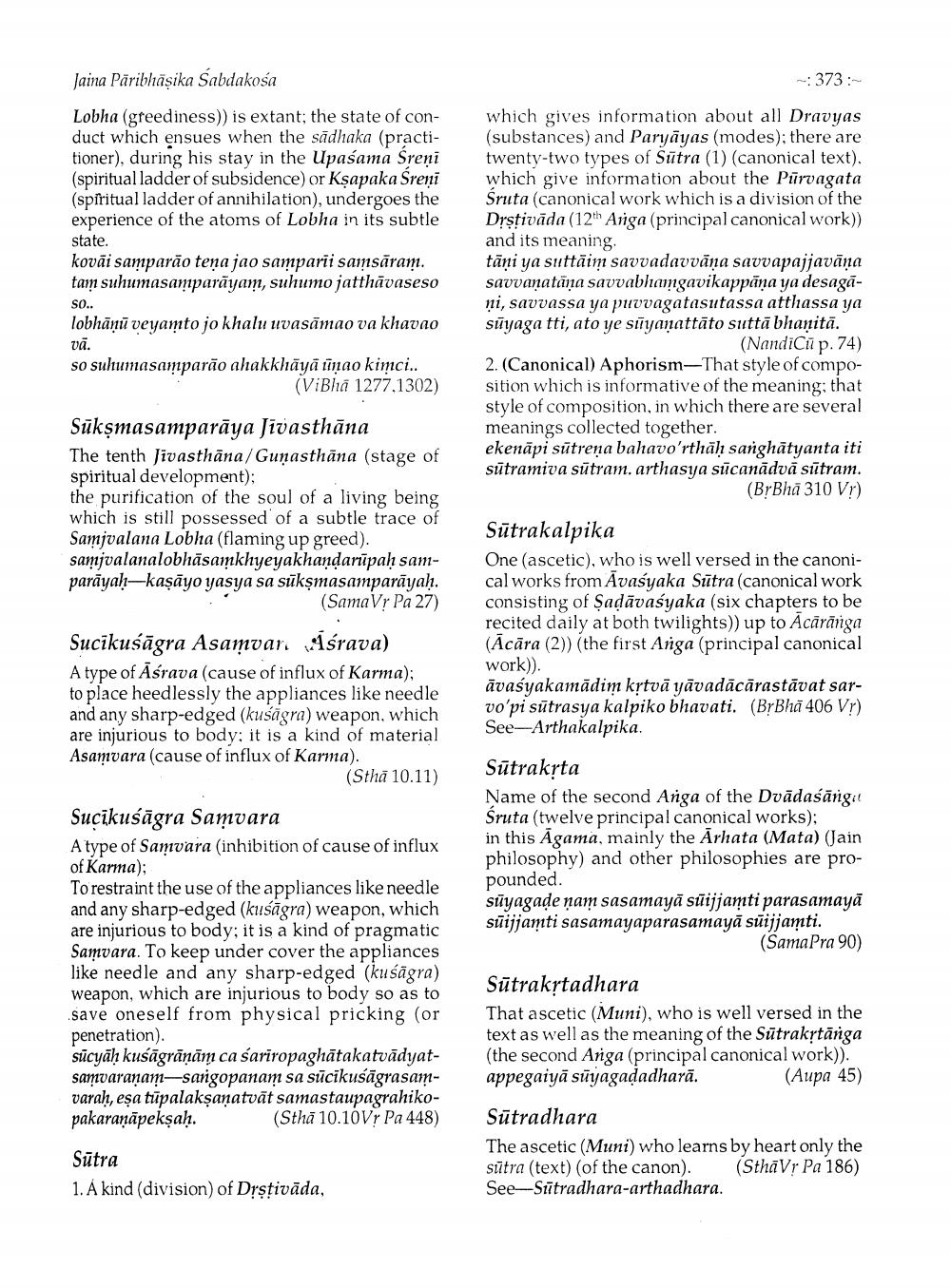________________
- 373:
Jaina Pāribhāșika Sabdakosa Lobha (greediness)) is extant; the state of conduct which ensues when the sādhaka (practitioner), during his stay in the Upasama Sreņi (spiritual ladder of subsidence) or Ksapaka Sreni (spiritual ladder of annihilation), undergoes the experience of the atoms of Lobha in its subtle state. kovāi samparāo tenajao samparii samsāram. tam suhumasamparāyam, suhumo jatthāvaseso so.. lobhāņū veyamtojo khalu uvasāmao va khavao vā. so suhumasamparão ahakkhāyā unao kimci..
(ViBha 1277,1302)
which gives information about all Dravyas (substances) and Paryāyas (modes); there are twenty-two types of Sūtra (1) (canonical text). which give information about the Pūrvagata Sruta (canonical work which is a division of the Drstivāda (12th Ariga (principal canonical work)) and its meaning tāni ya suttäim savvadavväna savvapajjavāna savvanatana savvabhaingavikappana ya desagāņi, savvassa ya puvvagatasutassa atthassa ya sūyaga tti, ato ye sīīyanattāto suttā bhanitā.
(NandiCī p. 74) 2. (Canonical) Aphorism-That style of composition which is informative of the meaning: that style of composition, in which there are several meanings collected together. ekenāpi sūtrena bahavo'rthāh sanghātyanta iti sūtramiva sūtram. arthasya sūcanādvā sūtram.
(BrBhā 310 Vr)
Sükşmasamparāya Jivasthāna The tenth Jivasthāna/Gunasthāna (stage of spiritual development); the purification of the soul of a living being which is still possessed' of a subtle trace of Samjvalana Lobha (flaming up greed). samjvalanalobhāsamkhyeyakhandarūpah samparāyaḥ-kaṣāyo yasya sa sūkşmasamparāyaḥ.
(SamaVr Pa 27)
Sūtrakalpika One (ascetic), who is well versed in the canonical works from Avasyaka Sūtra (canonical work consisting of Sadāvasyaka (six chapters to be recited daily at both twilights)) up to Acārārga (Ācāra (2)) (the first Ariga (principal canonical work)) āvasyakamādim kytvā yāvadācārastāvat sarvo'pi sūtrasya kalpiko bhavati. (BrBhā 406 Vr) See-Arthakalpika.
Sucikušāgra Asamvarı śrava) A type of Āśrava (cause of influx of Karma); to place heedlessly the appliances like needle and any sharp-edged (kusāgra) weapon, which are injurious to body; it is a kind of material Asamvara (cause of influx of Karma).
(Stha 10.11)
Sūtrakrta Name of the second Arga of the Dvādasānga Sruta (twelve principal canonical works); in this Agama, mainly the Arhata (Mata) (Jain philosophy) and other philosophies are propounded. süyagade nam sasamayā sūijjamti parasamayā sūijjamti sasamayaparasamayā sūijjamti.
(Sama Pra 90)
Sucīkuśāgra Samvara A type of Samvara (inhibition of cause of influx of Karma); To restraint the use of the appliances like needle and any sharp-edged (kusāgra) weapon, which are injurious to body; it is a kind of pragmatic Samvara. To keep under cover the appliances like needle and any sharp-edged (kuśägra) weapon, which are injurious to body so as to save oneself from physical pricking (or penetration). sūcyāḥ kuśāgrāņām ca śarīropaghātakatvādyatsamvaranam-sargopanam sa sūcikusāgrasamvarah, eşa tūpalaksanatvāt samastaupagrahikopakaraṇāpekṣaḥ
(Stha 10.10V; Pa 448)
Sūtrakrtadhara That ascetic (Muni), who is well versed in the text as well as the meaning of the Sūtrakytānga (the second Ariga (principal canonical work)). appegaiyā sūyagadadharā. (Aupa 45)
Sutra 1. Á kind (division) of Drstivāda,
Sūtradhara The ascetic (Muni) who learns by heart only the sūtra (text) (of the canon). (SthāVr Pa 186) See-Sutradhara-arthadhara.




